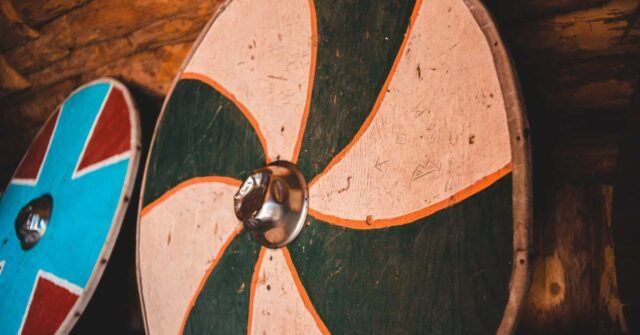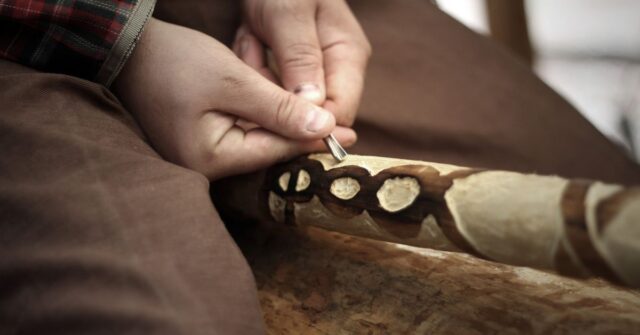Viking culture, often associated with fierce warriors and legendary seafaring, also had a rich tradition of sculpture and statuary that reflected their beliefs, mythology, and societal values.
While not as widely recognized as their shipbuilding or metalwork, Viking sculptures played a crucial role in their cultural expression.
Introduction to Viking Sculpture
Viking sculpture is an often-overlooked aspect of their rich cultural heritage. These artworks provide valuable insights into the beliefs, practices, and daily life of the Norse people.
Through various materials and techniques, Vikings created pieces that were not only decorative but also deeply symbolic.

The Importance of Sculpture in Viking Society
Sculptures in Viking society were more than mere decorations. They served religious, commemorative, and functional purposes.
These art forms were integral to rituals, storytelling, and even in marking territories. The presence of statues and carvings in everyday items underscored their significance in Viking life.
Materials and Techniques Used in Viking Statuary
Viking artists utilized readily available materials such as wood, stone, and metal. Wood was commonly used due to its abundance and ease of carving, while stone was preferred for its durability in outdoor settings.
Metal, particularly bronze, was used for intricate and detailed pieces. Techniques included carving, casting, and engraving, showcasing the Vikings’ advanced craftsmanship.
Common Themes in Viking Sculpture
The themes of Viking sculpture reflect their worldviews and mythology. Common subjects included gods and goddesses, mythological creatures, and scenes from everyday life.
These themes were depicted with great attention to detail and stylistic elements unique to Viking art.
Mythological Representation
Viking sculptures often depicted figures from Norse mythology, reflecting their religious beliefs and stories passed down through generations.
Gods and Goddesses
Figures such as Odin, the all-father, Thor, the god of thunder, and Freya, the goddess of love and war, were frequently represented.
These statues were not only objects of veneration but also symbols of protection and power.
Each god and goddess was depicted with attributes that highlighted their roles and stories in Norse mythology.

Mythological Creatures
Creatures from Norse myths, such as dragons, wolves, and serpents, were also popular subjects.
These sculptures often embodied the chaos and danger believed to exist beyond the human world, serving as both warnings and protective symbols.
Everyday Life and Symbolism
In addition to mythological figures, Viking sculptures also depicted scenes from daily life and symbolic representations of their values and beliefs.
Depictions of Warriors
Warriors were a central theme in Viking art. Statues and carvings often depicted armored fighters in dynamic poses, emphasizing their martial prowess and heroism.
These depictions served to glorify the warrior ethos that was so central to Viking culture.
Animals and Nature
Animals, both real and mythical, were common motifs. Horses, ravens, and wolves featured prominently, often in symbolic roles.
These animals were not only part of the Viking environment but also held significant cultural and spiritual meanings.
Styles and Artistic Techniques
Viking art is characterized by its unique styles, which evolved over time and were influenced by interactions with other cultures. Two prominent styles are the Urnes and Borre styles.
Urnes Style
The Urnes style, named after the stave church in Norway, is known for its elegant and fluid lines.
This style often featured intricate patterns and interlacing designs, creating a sense of movement and complexity.
Characteristics and Patterns
The Urnes style is characterized by its slender, sinuous lines and elaborate animal motifs.
These designs often appear to weave in and out of each other, creating a dynamic and interconnected pattern.
The style is both sophisticated and visually striking, reflecting the artistic skill of the Viking craftsmen.
Examples of Urnes Style in Sculpture
Examples of the Urnes style can be seen in various artifacts, including wooden carvings, metalwork, and stone reliefs.
The intricate patterns and animal forms are evident in these pieces, showcasing the distinctive aesthetic of this style.
Borre Style
The Borre style, which predates the Urnes style, is known for its robust and more geometric patterns. This style often featured gripping beasts and interlocking loops, creating a sense of strength and solidity.
Distinctive Features
The Borre style is marked by its use of symmetrical patterns and bold, interlocking designs.
These motifs often included gripping beasts, which are stylized animals that appear to bite or grasp the surrounding elements.
The style is characterized by its strength and clarity, contrasting with the more fluid Urnes style.
Notable Artifacts
Notable artifacts in the Borre style include brooches, belt fittings, and other personal adornments.
These items often feature the characteristic gripping beast motif and demonstrate the widespread use of this style in Viking art.
Notable Examples of Viking Sculpture
Several notable examples of Viking sculpture have been discovered, offering insights into their artistic traditions and cultural practices.
These include runestones, grave goods, and public monuments.
Runestones
Runestones are some of the most significant and well-known examples of Viking sculpture.
These stones, inscribed with runes and often adorned with carvings, served various purposes, from commemorating the dead to marking territory.
Historical Significance
Runestones are invaluable historical records, providing insights into Viking society, language, and beliefs.
The inscriptions often commemorate important events or individuals, offering a glimpse into the lives and values of the Vikings.

Famous Runestones and Their Stories
Famous runestones, such as the Jelling Stones in Denmark, tell stories of kings, battles, and religious conversion.
These stones are not only historical records but also artistic masterpieces, showcasing the skill and creativity of Viking carvers.
Grave Goods and Figurines
Grave goods and figurines are another important category of Viking sculpture.
These items, often buried with the deceased, provide insights into Viking burial practices and beliefs about the afterlife.
Role in Burial Practices
Grave goods were intended to accompany the deceased into the afterlife, providing them with tools, weapons, and other items they might need.
Figurines, often depicting gods or animals, were included to offer protection and guidance.
Examples of Grave Figurines
Examples of grave figurines include small statues of warriors, animals, and deities. These items were crafted with great care and detail, reflecting their importance in Viking funerary rituals.
Public Sculptures and Monuments
Public sculptures and monuments were used to commemorate significant events and individuals.
These works of art were often displayed in prominent locations, serving as public statements of power and memory.

Commemorative Statues
Commemorative statues often depicted notable figures, such as kings and heroes.
These statues were intended to honor their achievements and ensure their legacy within the community.
Public Art and Its Impact
Public art played a crucial role in Viking society, serving as a means of communication and expression.
These sculptures were not only decorative but also conveyed important messages about identity, power, and cultural values.
The Role of Sculpture in Viking Rituals
Sculptures played a significant role in Viking religious practices and rituals. These artworks were used in various ceremonies and were believed to hold spiritual power.
Religious Practices
Religious practices in Viking society often involved the use of statues and carvings. These items were used in temples and shrines, serving as focal points for worship and offerings.
Sculptures in Temples and Shrines
Temples and shrines often contained statues of gods and goddesses, serving as tangible representations of the divine.
These sculptures were the focus of prayers, offerings, and other religious activities.
Ritual Use of Statues
Statues were also used in various rituals, such as sacrifices and ceremonies.
These items were believed to channel the power of the gods, providing protection and blessings to the participants.

Storytelling and Oral Tradition
Sculptures were an important part of Viking storytelling and oral tradition. These artworks helped to visually convey stories and legends, making them more memorable and impactful.
Using Sculptures to Tell Stories
Sculptures were used to illustrate stories from Norse mythology and history. These visual aids helped to bring the tales to life, making them more engaging and accessible to listeners.
Examples from Norse Mythology
Examples of storytelling through sculpture include carvings depicting scenes from the sagas and Eddas.
These artworks helped to preserve and transmit the rich oral traditions of the Vikings.
Preservation and Legacy of Viking Sculpture
The preservation and study of Viking sculpture have provided invaluable insights into their culture and art. These artifacts have survived centuries, offering us a glimpse into the past.
Archaeological Discoveries
Archaeological discoveries have unearthed many significant Viking sculptures.
These finds have helped historians and archaeologists piece together the artistic practices and cultural significance of Viking statuary.
Significant Finds
Significant archaeological finds include runestones, grave markers, and household items adorned with carvings.
Discoveries like the Oseberg ship burial, which contained intricately carved wooden objects, have provided a wealth of information about Viking art and daily life.

Insights Gained from Excavations
Excavations have revealed that Viking sculptures were not merely decorative but also functional and symbolic.
Items such as the Jelling stones and the Gokstad ship burial highlight the importance of sculpture in commemorating significant events and individuals.
Museum Collections
Museums around the world house extensive collections of Viking artifacts, including sculptures. These collections allow the public to view and appreciate the artistry of the Vikings.
Major Museums Housing Viking Artifacts
Major museums with notable collections of Viking artifacts include the National Museum of Denmark, the British Museum, and the Viking Ship Museum in Oslo.
These institutions preserve and display a wide range of Viking sculptures, from small figurines to large runestones.
Exhibitions and Public Interest
Exhibitions on Viking art and culture draw significant public interest, reflecting a fascination with Viking history.
Special exhibitions often focus on specific aspects of Viking art, providing in-depth looks at their craftsmanship and cultural significance.
Conclusion
Understanding the role of sculpture and statuary in Viking culture offers a deeper appreciation of their artistry and the cultural context from which these artifacts emerged.
These sculptures are not only works of art but also crucial historical documents that tell the story of a vibrant and complex society.

The Lasting Impact of Viking Sculpture
Viking sculpture has left a lasting legacy, influencing art and culture long after the Viking Age.
The intricate designs and powerful symbols found in Viking art continue to inspire modern artists and designers, keeping the spirit of the Vikings alive in contemporary culture.
Modern Interpretations and Influences
Modern interpretations of Viking sculpture can be seen in various forms of media, from films and television shows to books and video games.
These interpretations help to keep Viking culture relevant and exciting for new generations, ensuring that the legacy of Viking art endures.











